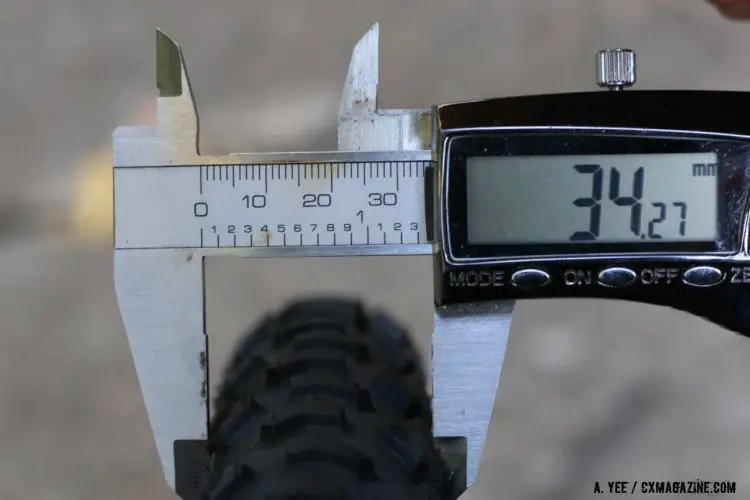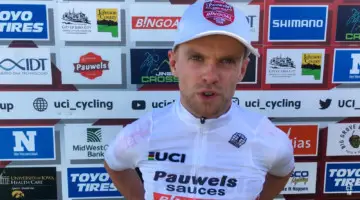By now you’ve heard about the UCI’s scaling back of the accepted tire width from 35mm to 33mm for Elite races. You have your opinions, and so do the pros. Elite racer Christine Vardaros gives her thoughts, as well as those of a few other pros and tire manufacturers, on the new restriction. Pick up Issue 10 of our magazine for a whole bunch of new tire reviews – including actual widths on “standard” road rims.
As of July 1st, a new UCI rule narrowing the maximum width of a cyclocross tire from 35mm to 33mm went into place. It may only be two millimeters, but the stir it has caused is much larger than that.
When I first heard of the ruling, my immediate thought was, “I’m screwed! Now I have to re-do half my wheels. That means time and money – two such luxuries that elude me at the moment.” Based on numerous conversations with others, I quickly realized I am not alone in my initial sentiment. Jonathan Page (Planet Bike) is one of the many riders who joins me in my misery. “I am not really that happy. I had to order and buy all new tires for the upcoming season … then I’ll spend a week or so taking old tires off, gluing new ones on. And I’ll have a pile of totally useless tires now,” said Page.
But the work of changing tires is only a small portion of the discussion surrounding this new rule. People want to know if all their 32s will measure out to be legal. What about if they get their hands on a Dugast custom 33mm, is that certifiably legal? Can they shrink a 34mm to measure 33? Will there really be someone checking each and every tire at all UCI races around the world – or is it just a waste of time to change tires?
For clarity, I turned to the UCI, as well as to some industry guys like Challenge, Tufo and Dugast.
While the UCI Technical Director Xavier Dafflon believes that the majority of competitors will simply ride 32mm tires, almost all of which are legal, he added, “Tire manufacturers are submitting new ones for pre-approval. Dugast is beginning to produce a few that are handmade, so there is a big risk that they are too big and not authorized in competition. The others too can produce 33mm if they want to do so. And if they are not submitted for pre-approval, they will be checked on site very easily by our official UCI commissaires.”
“The commissaires will be checking the width of tires on site, randomly or systematically, whenever they want, before, during and/or after the races. They will be very strict. If the width is not appropriate – I mean wider than 33mm – the rider is not allowed to compete, and is disqualified and/or fined.” -Dafflon
But according to Dugast owner Richard Nieuwhuis, UCI officials are going to have a tough time measuring each tire since they cannot simply read the sidewall of a tire for the width, as it is not terribly accurate, even for those tires pre-approved by UCI. “People think that the casing needs to be 33mm, but the widest part of the tire needs to be 33; some knobby tire treads are certainly not legal. For example, [Schwalbe’s] Racing Ralph [35mm] – I cannot make them into 32, even a 33mm. A lot of riders think they are inside the rule.”
In addition to the natural width variance between individual tires and the knob factor, wheel diameter and glue layer play a crucial role. Nieuwhuis explains, “Diameter of wheels are not all the same. Between the smallest and biggest wheels approved on the UCI site, there is a height difference of 6mm. Wheel diameter alone can make a difference in determining if you can use your 34mm legally. For instance, if you choose a big wheel like a Lightweight or Zipp, your 34mm may stretch enough to be 33. The UCI wasn’t thinking about wheel sizing, what it really does to a tire size. And more glue on the rim further increases the diameter of the wheel. This means the tire needs to be more stretched, taking away the thickness of the balloon.”
With Dugast Rhino 32’s on backorder in many stores in Belgium, some of the Dugast dealers are recommending to their clients that a 34mm can work within the UCI guidelines if you add an extra layer of glue and a strip of that dreaded glue tape. (Be forewarned that if you follow this advice, you may get some nasty stares from the other guys on the start line who think you have an advantage over their 32’s.)
If a tire is very close to the 33mm limit, mud can put it over the top. “I don’t see any UCI official taking a high pressure hose to clean the bikes for measuring,” quips Nieuwhuis.
As for the bottom line solution to this rule, Challenge tire President Alex Brauns says, “In the end our 32 is the new 33. There is tolerance on the 32 than can reach almost 33.”
Regarding the effect this rule has had on the industry, Brauns shares, “It has only created problems; we had to stop producing 34s halfway through the season while both customers and manufacturers were left confused. It would have been more professional to have announced the change at the end of the season, giving a one-year notice. This would mean it would go in effect in 2012-2013 season, which makes much more sense.”
According to UCI, “The intent was to reduce the amount of equipment that many riders feel they must bring in order to be competitive.” This was theoretically aimed at Junior riders from what a few of us have heard, to decrease their financial burden. Nieuwhuis strongly disagrees with this approach, stating:
“Juniors already have carbon bikes and mobile homes; I don’t see the need to block the amount of cash they spend.” If this rule is meant to help the rest of us, it has actually done the opposite since we now have to shell out more money than was originally necessary to race another season.” -Nieuwhuis
If they said it was to de-clutter the pits for safety’s sake, maybe I could buy that…although I’ve never heard that wheels were a problem, as they are usually stacked against the metal fences separating the pit boxes. Or better yet, if they thought this rule would increase fair play in the races, I could possibly stand behind that too. Sven Nys was once quoted as saying that 34mm mud tires make any technical section, such as the slippery Koppenbergcross descent, child’s play. By forcing everyone to ride 32s, it gives those technically gifted, such as Sven Nys, a chance to shine.
But where this rule leaves us is with fewer tire choices. Brauns sums it up best by saying, “Sven, [Bart] Wellens, [Niels] Albert and other top riders will still have a truck of wheels and tires behind them…the Juniors too.”
As for Tufo North America’s Vladimir Juhas’ stand on this topic, he had only one comment to add:
“We are not going to deal with this nonsense.” -Juhas





























